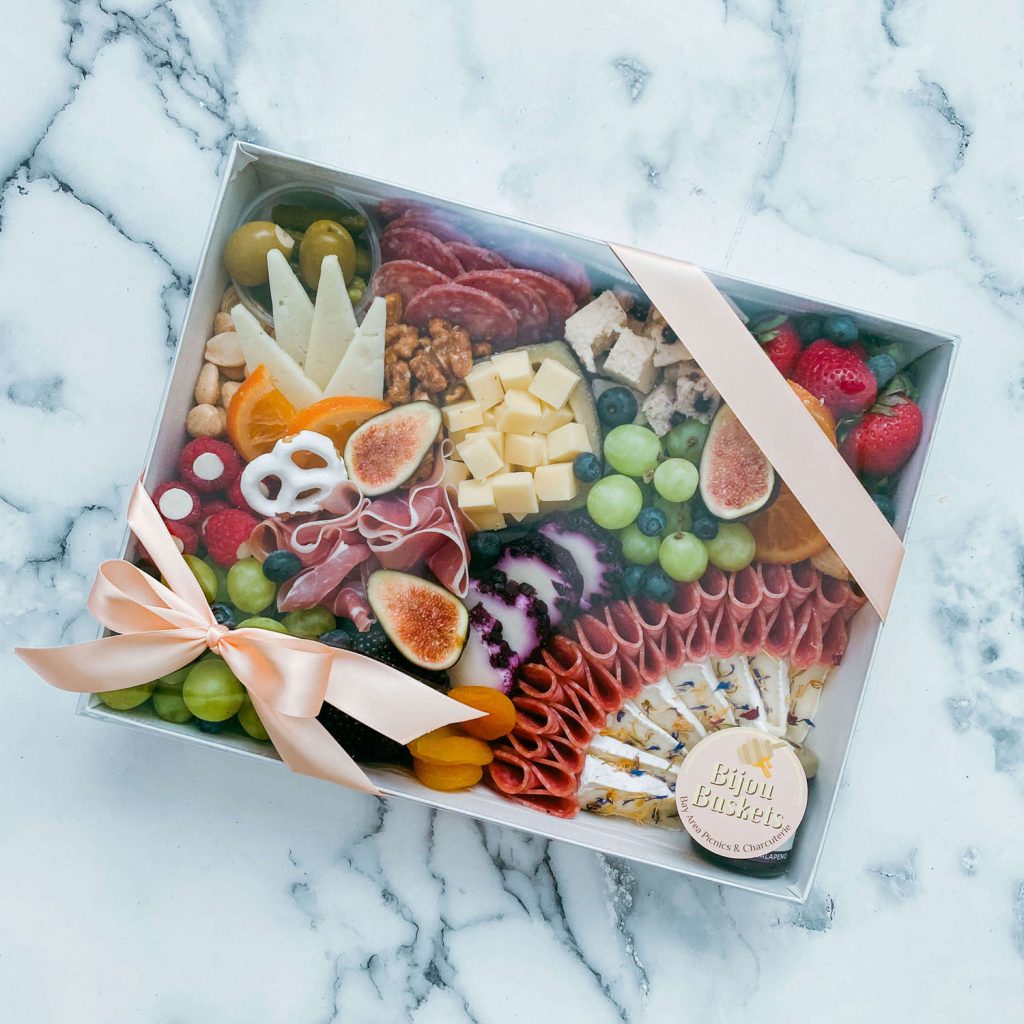
There’s a winery in northern California’s Napa Valley that’s been something of a one-stop picnicking spot for me, ever since I moved to the San Francisco Bay Area well over two-decades ago. What’s especially unique about V. Sattui—a family-owned slice of northern Italy—is not the Tuscan-style stone structure that rises prominently above its two-plus-acres of picnic grounds, these dotted with tables and shady oak trees—but instead is its fabulously stocked deli and marketplace. The only one of its kind at a Napa Valley winery, this vast retail space is brimming with artisan sausages and Italian meats, like dry-cured prosciutto and sliced bresaola made right onsite, dozens (if not hundreds) of firm, soft, goat and cow cheeses, jars of garlic parmesan dipping oil, bottles of balsamic vinegar, and sides of creamy polenta and roasted fingerling potatoes. There are made-to-order panini sandwiches, and cans of soda and sparkling water to go with the winery’s own peppery Zinfandels and crisp and light Sauvignon Blancs. I’ve come to this place with my parents, snacking on baguette loaves and creamy brie while squirrels played in the branches above us; and fallen asleep on a blanket spread across the grounds’ tall grasses, while my boyfriend devoured the rest of our market-bought tiramisu. In fact, these times at V. Sattui have been some of my most memorable experiences, and isn’t that exactly what a picnic should be?



Photos by Cami Jetta, Dinner Party (left & center) & Alyssa Tran, Bijou Baskets (right)
It’s little wonder that picnics are a worldwide phenomenon. From the Japanese hanami custom of lingering beneath the flowering cherry blossom of spring, taking in their beauty with family and friends while grazing on onigiri rice balls and skewered dando dumplings, to the lure of Scandinavian winters, bundled up at a snow-covered picnic table in the park sipping on thermoses of mulled wine and dining on plates of smoked salmon. West Africans might snack on abolo (steam rice cakes) and sticks of sugarcane amid the mist of a cascading waterfall, while in Turkey, local residents stock up on lamb kabobs and kuru köfte (dry meatballs) cooled with a dollop of cucumber/mint yogurt before heading to dedicated piknik yeri (picnic grounds). The United Kingdom even devotes an entire week to picnicking each June, highlighting picnic-worthy recipes such as sausage rolls and upside down banana cake, and providing tips, like bringing along bongo drums for a little self-made entertainment.
But while gathering together to dine, relax, converse, and reflect in a bucolic outdoor setting is undoubtedly a universal activity, what exactly is a picnic, and where did this phenomenon originate? Perhaps even more importantly, why is it that we love picnics like we do?


Photos by Alyssa Tran, Bijou Baskets
THE ORIGINS OF THE PICNIC
“It really depends on what you consider a picnic,” says food historian Dr. Eric Colleary. Eating outdoors has been a part of the cultural lexicon since the beginnings of humanity. However, while some picnics are well-planned affairs, others are casual and impromptu. “Picnics reflect the needs and resources of the participants,” Colleary says. “They range from elaborate—I think of Catherine the Great’s picnic basket, which was so large it took eight footmen to carry—to simple: perhaps just a basket of apples, farm cheese, and a knife.” When we picture a typical picnic in America, it often includes a spread of items like fruits, nuts, cheese, and charcuterie, not to mention wine. However, during the Medieval hunting feasts of Western Europe (considered to be one of the earliest versions of the picnic as we know it today), portable foods like bone-in ham and thick-crusted pastries were the norm. Then there are types of picnics that Colleary wrote about in his 2014 piece, “Planning Your Memorial Day Picnic,” highlighting the U.S. potluck picnics once associated with decorating gravesites. It’s a centuries-old custom that later morphed into Memorial Day. In fact, picnicking in cemeteries was extremely popular among Americans in the 1800s, and is still a regular pastime in countries like Greece, and Mexico, especially on the annual Día de los Muertos.
Although the exact origins of the picnic remain unknown, the name itself is thought to have derived in the 17th century from the French verb, pique (‘pick’ or ‘peck’) and the noun, nique (‘small’or ‘trifle’). Prior to 1789, a ‘‘pique-nique’ was often used in France to describe high-brow, salon-style soirees that took place indoors, and involved intellectual prowess as much as it did food and drink. But the French Revolution brought about huge social and political changes throughout Europe, opening doors for the middle class—in many ways, quite literally. With the royal parks and gardens of Paris now open to the public, people began taking their gatherings outside.
“Picnics reflect the needs and resources of the participants.”
Soon enough, picnics were catching on both across the Channel and across the ‘Pond.’ In the same vein as ‘Ratty’s picnic,’ a fictional feast that took place in British author Kenneth Grahame’s 1908 children’s classic, The Wind in the Willows, Londoners were packing up wicker luncheon-baskets known as “hampers” with helpings of cold chicken, pickled gherkins salad, and ginger beer and heading out into the English countryside for leisurely afternoon feasts. In the U.S., the invention of the automobile meant picnic-style ‘motor-lunches’ proliferated in the 1920s and ‘30s.
But while picnics have always remained popular, these alfresco gatherings experienced a huge resurgence with the Covid pandemic, as people started looking for creative ways to see family and friends in a safe and socially distant, outdoor environment. This inspired the rise of picnic-based businesses, too. For example, Alyssa Tran is the founder of Bijou Baskets, a gourmet picnic and charcuterie company based in San Jose, California, which she began during the pandemic. “People were getting pretty tired of just being at home,” says Tran, “so I thought, why not start selling an all-inclusive picnic activity bundle [complete with a wicker basket, dishware, picnic blanket, and a charcuterie board] like the one I putting together for me and my friends.”
WHAT A PICNIC ENTAILS
According to Cami Jetta, the founder of Dinner Party, a new restaurant in Brooklyn’s Fort Greene neighborhood that has been selling weekly to-go ‘picnic boxes’ throughout summer, the best picnic foods are “pleasant to eat at room temperature, travel well, and lend themselves well to sharing with other people.” This precludes anything that’s super saucy, or typically eaten piping hot. Instead, consider foods that are either pre-cooked or -baked, like fried chicken, hard-boiled eggs, biscuits, and pies, or can be eaten in their natural state, like fruits and nuts. “Foods that, even if you aren’t going to be able to eat them for an hour or two after they’re packed away, are still going to be delicious,” says Jetta.
While some picnickers prefer carrying everything in a traditional basket, replete with pockets for storing wine, plates and silverware, others opt for a backpack (picnic backpacks are a popular hybrid). If you’ll be spreading out on the grass, a spacious blanket makes all the difference. For picnic tables, a colorful tablecloth can help heighten the experience instead. Camping chairs, collapsible picnic tables, and shade canopies are all ways to add a bit of extra picnic comfort, while a frisbee, bocce ball set, or corn hole can turn a casual get-together into a full-blown party.
1. SELECTING THE INGREDIENTS
Pre-packed meals like those served up at Dinner Party, Bijou Baskets’ charcuterie boards, or bento boxes from a Japanese grocer, such as San Francisco’s Nijiya Market, are easy ways to put together a picnic in a flash. However, if you’d like to get creative, Tran believes that selecting ingredients should be part of the fun. She often finds herself combing the shelves of grocery stores like Whole Foods and Trader Joe’s for the perfect blend of items, as well as perusing the stalls of local farmers’ markets and visiting specialty stores like Zanotto’s, a family-run Italian market in her city loaded with epicurean meats, cheeses, and spreads (think guacamole and hummus).
Trans also suggests seeking out an item or two that will elevate your picnic into something extra spectacular. For example, cotton candy grapes, a sweet and juicy hybrid that look like regular green grapes but taste incredibly similar to your favorite carnival food. She also loves triple crème brie. “There’s one from Marin French, made right up in Petaluma [just north of San Francisco],” Tran says, “so it’s a local cheese. I include it in almost every box.”



Photos by Alyssa Tran, Bijou Baskets
More of her go-tos include blueberry vanilla chevre, a creamy and tangy goat cheese that Tran’s customers can’t seem to get enough of, and rosé-soaked Toscano cheese, which she purchases from Trader Joe’s. Another is Alp Blossom, a semi-hard alpine cheese with an edible rind of flora bits that include lavender, marigold, and chervil. “So when you slice it you get little pieces of flowers with it,” Tran says. There are also the meats: dry-cured provisions like soppressata, prosciutto, and spicy coppa, as well as speciality salamis ranging from wild boar to black truffle.
Dinner Party focuses its picnic boxes on one main dish or item, and then builds a menu around it. Zetta also prefers structuring her menus around the time of year or the weather. If it’s scorching hot outside, she opts for dishes that are cooling. Or say it’s overcast. Then a menu that evokes coziness, featuring foods like chili and chocolate brownies, is especially ideal.


Photos by Cami Jetta, Dinner Party
2. PUTTING IT ALL TOGETHER
Dinner Party’s picnic boxes each feature six food items that play off each other in a sensory way, taking into account complimentary flavors, textures, and overall appearance. “We’re always brainstorming,” says Jetta. “We’ll start with one thing and then think, ‘what can we add that’s going to create a bit of cohesiveness or evoke a certain feeling or memory?’”
To incorporate homemade breadcrumbs and sauces, Jetta utilizes her trusty food processor (“We’ve named ours Carson,” Jetta says, “and she’s the star of the show”). However, there’s one item that she’ll never throw a picnic without: multiple serving spoons. “I wish that we could hand out serving spoons to everyone when they come and get their food,” says Jetta, noting it’s an item that many people often forget.
3. FINDING THE PERFECT PICNIC SPOT
“I tend to look for places that are picturesque, not too crowded, and where you can always find a level and open space,” says Tran. One of her favorite picnic spots is San Jose’s Municipal Rose Garden, with its rolling green lawns and seemingly endless rose varieties, including ruffed Bonbons and light-pink Olés. Another Bay Area spot that her customers love: the North Dutch Windmill in San Francisco’s Golden Gate Park. Its accompanying garden is quiet, cozy, and often covered in tulips.
“At a picnic you have the opportunity to try little bites of everything,” says Jetta, “be with others, eat with your hands, hang outside… Honestly, what could be better?”
4. ENJOYING YOURSELF
While the multitude of dishes and distinct outdoor setting are motive enough to love a picnic, another main reason that they’re so appealing is that picnics are fun, experiential, and often bring together groups of friends, family, and even strangers over the one thing that unites us all: food. “At a picnic you have the opportunity to try little bites of everything,” says Jetta, “be with others, eat with your hands, hang outside… Honestly, what could be better?”
Related Articles
-
 Travel & Culture March 16, 2020 | 6 min read Significance of Sustenance: Burlington I grew up in the shadow of the slopes in the Pocono Mountains, but the icy Pennsylvania conditions made skiing decidedly unfun for fall-prone little-ol’ me.
Travel & Culture March 16, 2020 | 6 min read Significance of Sustenance: Burlington I grew up in the shadow of the slopes in the Pocono Mountains, but the icy Pennsylvania conditions made skiing decidedly unfun for fall-prone little-ol’ me. -
 Travel & Culture April 02, 2020 | 8 min read A Brooklyn Pizzeria Fights Through COVID-19 COVID-19 hit the city like a slow-moving hurricane. We knew it was coming, but we were still in shock. Everything was uncertain.
Travel & Culture April 02, 2020 | 8 min read A Brooklyn Pizzeria Fights Through COVID-19 COVID-19 hit the city like a slow-moving hurricane. We knew it was coming, but we were still in shock. Everything was uncertain. -
 Travel & Culture June 23, 2020 | 6 min read Distinctive Process: Maori Hangi Steaming geothermal pools set against a vivid blue sky, in the middle of lush natural surroundings and a day spent soaking up indigenous Maori culture.
Travel & Culture June 23, 2020 | 6 min read Distinctive Process: Maori Hangi Steaming geothermal pools set against a vivid blue sky, in the middle of lush natural surroundings and a day spent soaking up indigenous Maori culture.





